An oxygen isotope test for the origin of Archean mantle roots
Affiliations | Corresponding Author | Cite as | Funding information- Share this article





Article views:3,907Cumulative count of HTML views and PDF downloads.
- Download Citation
- Rights & Permissions
top
Abstract
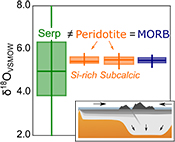
Schulze, D.J. (1986) Calcium anomalies in the mantle and a subducted metaserpentinite origin for diamonds. Nature 319, 483–485.
; Canil and Lee, 2009Canil, D., Lee, C.-T.A. (2009) Were deep cratonic mantle roots hydrated in Archean oceans? Geology 37, 667–670.
). We present oxygen isotope data from 93 mantle peridotites from five different Archean cratons to evaluate their possible origin as serpentinites. Cratonic mantle peridotite shows remarkably uniform δ18O values, identical to modern MORB-source mantle, that do not vary with bulk rock Si-enrichment or Ca-depletion. These data clearly conflict with any model for cratonic lithosphere that invokes serpentinite as a protolith for cratonic peridotite, and place additional constraints on cratonic mantle origins. We posit that the uniform δ18O was produced by sub-arc and/or MOR depletion processes and that the Si-enriched nature of some samples is unlikely to be related to slab melt infiltration. Instead, we suggest a peridotitic source of Si-enrichment, derived from ascending mantle melts, or a water-fluxed depleted mantle. These variably Si-enriched, cratonic mantle protoliths were then collisionally compressed into the thick cratonic roots that have protected Earth’s oldest continental crust for over 2.5 Gyr.Figures and Tables
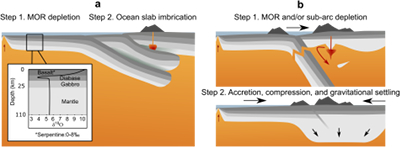 Figure 1 Popular models of cratonic mantle formation. (a) Imbrication of MOR sequences to form a thick lithosphere. An estimated oxygen isotope profile through Neoarchean oceanic lithosphere is inset. (b) Depleted cratonic mantle protoliths produced at MOR and in sub-arc environments are compressed via pure shear into a thick lithospheric root. | 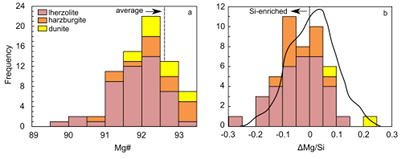 Figure 2 (a) Mg# histogram of olivines in this study. Mg#s are both more and less depleted than the worldwide average for olivine in cratonic peridotite, denoted by the dotted line (Pearson and Wittig, 2008). (b) ΔMg/Si histogram of samples compared to a vertically unscaled probability density function for worldwide cratonic mantle xenoliths from Canil and Lee (2009). Negative ΔMg/Si designates Si-enriched lithologies. | 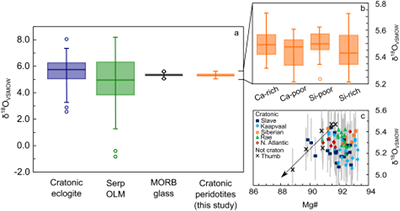 Figure 3 (a) Box-whisker plot of the oxygen isotopic composition of cratonic peridotites, calculated from olivine δ18O, compared to eclogitic xenoliths, serpentinised oceanic lithospheric mantle (OLM), and MORB glass (Supplementary Information). (b) A box-whisker plot of peridotite δ18O, divided into statistically insignificant chemical discriminators – Ca-rich (lherzolitic), Ca-poor (harzburgitic/dunitic) and Si-enriched (-ΔMg/Si) and depleted lithologies (+ΔMg/Si), demonstrates that there is no variation in the distribution of oxygen isotopes with bulk rock chemistry. (c) Scatter plot of olivine δ18O and Mg#. The lack of correlation in the cratonic mantle suite contrasts to the trendline of The Thumb xenoliths (r2 = 0.86). | 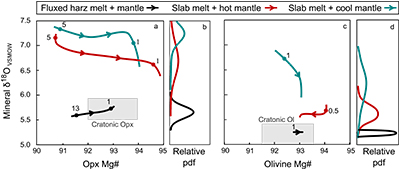 Figure 4 pMELTS modelling of slab melts (δ18O of +8 ‰) reacting with 900 ℃ (blue) and 1500 °C (red) harzburgite, as well as a water-fluxed harzburgitic (harz) melt (δ18O of +5.6 ‰) reacting with 1300 ℃ harzburgite (black). The major element and isotopic evolution of crystallising Opx (a) and olivine (c) is indicated by smoothed curves. Numbers indicate the slab melt/assimilated peridotite ratio. Typical cratonic mantle Opx and olivine (Ol) is outlined in gray fields. Relative Kernel estimations of the probability density function (pdf) for Opx (b) and olivine (d) δ18O are included. |
| Figure 1 | Figure 2 | Figure 3 | Figure 4 |
top
Models of Craton Formation
An essential element to the study of the growth and longevity of Earth’s continental crust is the origin of the chemically buoyant and rigid lithospheric mantle that underpins ancient continental cratons. The vast majority of geochemical evidence for the origin of cratonic peridotites supports initial melt extraction at pressures ≤5 GPa, with most melting occurring in the spinel stability field. This depletion in a shallow, spinel-bearing environment is indicated by low concentrations of mildly incompatible elements and the Cr-rich nature of garnet in cratonic peridotites (Stachel et al., 1998
Stachel, T., Viljoen, K.S., Brey, G., Harris, J.W. (1998) Metasomatic processes in lherzolitic and harzburgitic domains of diamondiferous lithospheric mantle: REE in garnets from xenoliths and inclusions in diamonds. Earth and Planetary Science Letters 159, 1–12.
; Canil, 2004Canil, D. (2004) Mildly incompatible elements in peridotites and the origins of mantle lithosphere. Lithos 77, 375–393.
; Brey and Shu, 2018Brey, G.P., Shu, Q. (2018) The birth, growth and ageing of the Kaapvaal subcratonic mantle. Mineralogy and Petrology 1–19.
). If a moderate to low pressure origin is accepted, then two end member models remain. The first model (Fig. 1a) invokes the successive imbrication of subducted oceanic lithosphere (e.g., Helmstaedt and Schulze, 1989Helmstaedt, H., Schulze, D.J. (1989) Southern African kimberlites and their mantle sample: Implications for Archean tectonics and lithosphere evolution. Kimberlites and Related Rocks 1, 358–368.
; Pearson and Wittig, 2008Pearson, D.G., Wittig, N. (2008) Formation of Archaean continental lithosphere and its diamonds: the root of the problem. Journal of the Geological Society 165, 895–914.
). The second model – collisional compression via pure shear (Fig. 1b) - proposes that depleted mantle protoliths from Neoarchean sub-arc settings and/or in hot spreading centres are tectonically amalgamated, compressed, and gravitationally thickened during cooling (Jordan, 1978Jordan, T.H. (1978) Composition and development of the continental tectosphere. Nature 274, 544–548.
; Lee et al., 2011Lee, C.-T.A., Luffi, P., Chin, E.J. (2011) Building and Destroying Continental Mantle. Annual Review of Earth and Planetary Sciences 39, 59–90.
; Wang et al., 2016Wang, H., van Hunen, J., Pearson, D.G. (2016) Making Archean cratonic roots by lateral compression: A two-stage thickening and stabilization model. Tectonophysics, doi: 10.1016/j.tecto.2016.12.001.
). The serpentinite-like major element signatures of some peridotites (Si-enriched bulk rock and subcalcic garnets) have been used to support the imbrication of hydrated oceanic lithosphere (Schulze, 1986Schulze, D.J. (1986) Calcium anomalies in the mantle and a subducted metaserpentinite origin for diamonds. Nature 319, 483–485.
; Canil and Lee, 2009Canil, D., Lee, C.-T.A. (2009) Were deep cratonic mantle roots hydrated in Archean oceans? Geology 37, 667–670.
). However, these cratonic peridotites have not been systematically tested for the distinctive oxygen isotopic ratios that are characteristic of serpentinites. Here, we search for these distinctive isotopic signatures in mantle-derived cratonic xenoliths.
Figure 1 Popular models of cratonic mantle formation. (a) Imbrication of MOR sequences to form a thick lithosphere. An estimated oxygen isotope profile through Neoarchean oceanic lithosphere is inset. (b) Depleted cratonic mantle protoliths produced at MOR and in sub-arc environments are compressed via pure shear into a thick lithospheric root.
top
Approach and Results
To characterise the oxygen isotopic composition of cratonic mantle peridotites we present ion microprobe analyses (Supplementary Information) of olivines from coarse, “low-temperature” peridotite xenoliths (Table S-1), thought to represent the bulk of the cratonic lithospheric mantle. The sample suite is derived from the Slave, Rae, North Atlantic, Kaapvaal, and Siberian Archean cratons, and excludes cratonic peridotites that were modified after emplacement by high temperature deformation and melt metasomatism. We also report precise laser fluorination and ion probe measurements on cratonic mantle orthopyroxene (Opx) as well as olivine from forearc peridotites.
Our samples span both sides of the average cratonic mantle olivine Mg# (molar Mg/Mg+Fe) of 92.6 (Fig. 2a). A subset of our samples are Si-enriched, manifested as high bulk rock SiO2 and elevated modal Opx contents. We adopt the ΔMg/Si parameter of Canil and Lee, 2009
Canil, D., Lee, C.-T.A. (2009) Were deep cratonic mantle roots hydrated in Archean oceans? Geology 37, 667–670.
to quantify Si-enrichment (Fig. 2b), where negative ΔMg/Si denotes Si-enriched, or a lower Mg/Si and Al/Si than can be produced by experimental partial melts of peridotite.
Figure 2 (a) Mg# histogram of olivines in this study. Mg#s are both more and less depleted than the worldwide average for olivine in cratonic peridotite, denoted by the dotted line (Pearson and Wittig, 2008
Pearson, D.G., Wittig, N. (2008) Formation of Archaean continental lithosphere and its diamonds: the root of the problem. Journal of the Geological Society 165, 895–914.
). (b) ΔMg/Si histogram of samples compared to a vertically unscaled probability density function for worldwide cratonic mantle xenoliths from Canil and Lee (2009)Canil, D., Lee, C.-T.A. (2009) Were deep cratonic mantle roots hydrated in Archean oceans? Geology 37, 667–670.
. Negative ΔMg/Si designates Si-enriched lithologies.Our measurements reveal that cratonic mantle olivines are normally distributed (Shapiro-Wilk W = 0.99, p = 0.52) over an extremely restricted δ18O range of +5.01 to +5.53 ‰, with a mean of 5.26 ± 0.22 ‰ (2σ). There are no statistically significant deviations in δ18O with chemical proxies (Fig. S-1). Additionally, cratonic mantle Opx from variably Si-enriched xenoliths (Table S-2; mean δ18O of 5.74 ± 0.27 ‰) are in isotopic equilibrium with associated olivine (αenstatite–olivine at 1300 °C = ~0.5 ‰; Rosenbaum et al., 1994
Rosenbaum, J.M., Kyser, T.K., Walker, D. (1994) High temperature oxygen isotope fractionation in the enstatite-olivine-BaCO3 system. Geochimica et Cosmochimica Acta 58, 2653–2660.
).In order to determine if there are crustal sources of oxygen in the cratonic mantle, we compare our dataset to the well-defined MORB-source mantle (Fig. S-1). We adjust our olivine δ18O to whole rock peridotite values using a fractionation factor that accounts for the ultramafic composition. Oxygen isotope fractionation between an ultramafic peridotitic mantle source and olivine at high mantle temperatures has been estimated at ~0.2 ‰ (Valley et al., 1998
Valley, J.W., Kinny, P.D., Schulze, D.J., Spicuzza, M.J. (1998) Zircon megacrysts from kimberlite: oxygen isotope variability among mantle melts. Contributions to Mineralogy and Petrology 133, 1–11.
), based on a basalt-olivine fractionation of 0.32 ‰ at 1300 °C (Eiler et al., 2000Eiler, J.M., Crawford, A., Elliott, T., Farley, K.A., Valley, J.W., Stolper, E.M. (2000) Oxygen Isotope Geochemistry of Oceanic-Arc Lavas. Journal of Petrology 41, 229–256.
) and the positive correlation between melt SiO2 and Dmelt-olivine (Eiler, 2001Eiler, J.M. (2001) Oxygen Isotope Variations of Basaltic Lavas and Upper Mantle Rocks. Reviews in Mineralogy and Geochemistry 43, 319–364.
). A bootstrapped Kolmogorov-Smirnov (K-S) statistical evaluation of the MORB dataset and the 0.2 ‰ fractionation-corrected cratonic mantle olivines indicates that they are statistically indistinguishable (D = 0.11, p = 0.57), with both populations having analytical uncertainties equal to or larger than the population variance. In contrast, serpentinised peridotite and cratonic mantle olivine have clearly distinct distributions (D = 0.54, p << 0.05; Fig. 3a).
Figure 3 (a) Box-whisker plot of the oxygen isotopic composition of cratonic peridotites, calculated from olivine δ18O, compared to eclogitic xenoliths, serpentinised oceanic lithospheric mantle (OLM), and MORB glass (Supplementary Information). (b) A box-whisker plot of peridotite δ18O, divided into statistically insignificant chemical discriminators – Ca-rich (lherzolitic), Ca-poor (harzburgitic/dunitic) and Si-enriched (-ΔMg/Si) and depleted lithologies (+ΔMg/Si), demonstrates that there is no variation in the distribution of oxygen isotopes with bulk rock chemistry. (c) Scatter plot of olivine δ18O and Mg#. The lack of correlation in the cratonic mantle suite contrasts to the trendline of The Thumb xenoliths (r2 = 0.86).
top
Implications for Craton Formation
The striking similarity between oxygen isotope compositions of present day MORB and Archean cratonic peridotites documents the stability of the δ18O of Earth’s mantle over a 3 billion year interval. Despite this, the diverse δ18O values of cratonic eclogite xenoliths demonstrate that δ18O heterogeneities in the subcontinental lithospheric mantle can persist even at the metre scale, likely due to the slow diffusion of oxygen. Since hydrothermal alteration, or the serpentinisation of ultramafic rocks, is an effective method of producing highly variable δ18O (Wenner and Taylor, 1971
Wenner, D.B., Taylor, H.P. (1971) Temperatures of serpentinization of ultramafic rocks based on O18/O16 fractionation between coexisting serpentine and magnetite. Contributions to Mineralogy and Petrology 32, 165–185.
), cratonic mantle olivines derived by prograde metamorphism of serpentinite (Canil and Lee, 2009Canil, D., Lee, C.-T.A. (2009) Were deep cratonic mantle roots hydrated in Archean oceans? Geology 37, 667–670.
) should retain both serpentinite-like major element chemistry and distinct oxygen isotopic compositions (Fig 3a).In contrast to the extreme δ18O variability of Phanerozoic serpentinite (0 to +8 ‰; Fig. 3a), cratonic peridotitic olivines are strikingly uniform, even over the full compositional range typical for Archean lithospheric mantle. Olivines co-existing with subcalcic garnets and from Si-enriched peridotites - proposed signatures of a serpentinite origin (Schulze, 1986
Schulze, D.J. (1986) Calcium anomalies in the mantle and a subducted metaserpentinite origin for diamonds. Nature 319, 483–485.
; Canil and Lee, 2009Canil, D., Lee, C.-T.A. (2009) Were deep cratonic mantle roots hydrated in Archean oceans? Geology 37, 667–670.
) - have oxygen isotope compositions that are statistically indistinguishable from normal upper mantle (Fig. 3b). A key piece of evidence previously used in support of the meta-serpentinite hypothesis was a reported correlation between δ18O and Mg/Si from Colorado Plateau peridotitic xenoliths (Canil and Lee, 2009Canil, D., Lee, C.-T.A. (2009) Were deep cratonic mantle roots hydrated in Archean oceans? Geology 37, 667–670.
). We note that this Proterozoic terrane is not under-pinned by an Archean cratonic root, and shows clear evidence of hydrous weakening and thinning (Li et al., 2008Li, Z.-X.A., Lee, C.-T.A., Peslier, A.H., Lenardic, A., Mackwell, S.J. (2008) Water contents in mantle xenoliths from the Colorado Plateau and vicinity: Implications for the mantle rheology and hydration-induced thinning of continental lithosphere. Journal of Geophysical Research 113, 1–22.
). Furthermore, our replotting of these data resolves a correlation (r2 = 0.89) between δ18O and Mg# (Fig. 3c). This trend is not consistent with a metaserpentinite origin, as serpentine minerals are commonly higher in Mg# than the initial olivine and Opx that they replace (Evans, 2008Evans, B.W. (2008) Control of the Products of Serpentinization by the Fe2+Mg−1 Exchange Potential of Olivine and Orthopyroxene. Journal of Petrology 49, 1873–1887.
). Therefore, these samples likely do not represent the products of seafloor alteration processes (Canil and Lee, 2009Canil, D., Lee, C.-T.A. (2009) Were deep cratonic mantle roots hydrated in Archean oceans? Geology 37, 667–670.
), but may instead be a consequence of the water-rich metasomatism of the Colorado Plateau lithospheric mantle by Si-enriched fluids or melts from the low-angle subducting Farallon Plate at 80-35 Ma (Li et al., 2008Li, Z.-X.A., Lee, C.-T.A., Peslier, A.H., Lenardic, A., Mackwell, S.J. (2008) Water contents in mantle xenoliths from the Colorado Plateau and vicinity: Implications for the mantle rheology and hydration-induced thinning of continental lithosphere. Journal of Geophysical Research 113, 1–22.
). Finally, as the narrow variance in Archean cratonic mantle peridotite is statistically equivalent to that of MORB, there is no evidence for even small inputs of meta-serpentinite. Hence, meta-serpentinite is an unlikely protolith to the peridotitic root of the Colorado Plateau, and can be rejected as a protolith for Archean cratonic mantle.While the Colorado Plateau lithosphere is not a good proxy for pristine cratonic mantle, it is a geometric analogue for the Archean slab imbrication model. The low angle subduction that occurred underneath the Colorado Plateau in the Cretaceous to Eocene likely injected slab melts/fluids directly into the overlying lithospheric mantle, offsetting δ18O, ΔMg/Si, and Mg#. The similar geometry required for the Archean slab imbrication model would likely produce the same geochemical traces in cratonic mantle olivine. Since our extensive suite of cratonic mantle olivines does not show “Colorado Plateau-like” systematics (between δ18O and metasomatic proxies - ΔMg/Si or Mg#; Figs. 3c, S-2), it is unlikely that cratonic mantle thickening occurred by slab imbrication. This lack of a crustal alteration signature would be in line with suggestions of higher pressure melting in plumes, but such a model can be rejected from other considerations that place melt depletion in the spinel stability field (see discussion in Introduction). Instead, we hypothesise that cratonic mantle protoliths were initially depleted at MOR and/or at water fluxed sub-arc mantle wedges, environments that produce material with canonical mantle-like δ18O (Table S-3). These protoliths were then thickened, without significant isotopic modification, by pure shear compression to form cratonic mantle roots (Jordan, 1978
Jordan, T.H. (1978) Composition and development of the continental tectosphere. Nature 274, 544–548.
; McKenzie and Priestley, 2016McKenzie, D., Priestley, K. (2016) Speculations on the formation of cratons and cratonic basins. Earth and Planetary Science Letters 435, 94–104.
; Wang et al., 2016Wang, H., van Hunen, J., Pearson, D.G. (2016) Making Archean cratonic roots by lateral compression: A two-stage thickening and stabilization model. Tectonophysics, doi: 10.1016/j.tecto.2016.12.001.
).While our data is consistent with the construction of cratons by collisional compression of un-altered, depleted peridotite protoliths, we still require a means to enrich these regions heterogeneously in high-Si Opx. Many explanations for cratonic mantle Opx enrichment rely on the infiltration of slab derived melts (e.g., Rudnick, 1994
Rudnick, R.L. (1994) Northern Tanzanian peridotite xenolith: a comparison with Kaapvaal peridotites and evidence for carbonatite interaction with ultra-refractory residues. Proceedings of the 5th International Kimberlite Conference, 336–353.
; Kelemen et al., 1998Kelemen, P.B., Hart, S.R., Bernstein, S. (1998) Silica enrichment in the continental upper mantle via melt/rock reaction. Earth and Planetary Science Letters 164, 387–406.
). However, lithosphere that has been thinned by crustal melt infiltration is marked by low Mg# and exotic δ18O (Wang et al., 2018Wang, C.-G., Xu, W.-L., Yang, D.-B., Liu, Y.-S., Pei, F.-P., Li, Q.-L., Zhou, Q.-J. (2018) Olivine Oxygen Isotope Evidence for Intracontinental Recycling of Delaminated Continental Crust. Geochemistry, Geophysics, Geosystems 19, 1–12.
). Using pMELTS isenthalpic modelling (Ghiorso et al., 2002Ghiorso, M.S., Hirschmann, M.M. Riners, P.W., Kress, V.C. (2002) The pMELTS: A revision of MELTS for improved calculation of phase relations and major element partitioning related to partial melting of the mantle to 3 GPa. Geochemistry, Geophysics, Geosystems 3, 1–36.
) of assimilation-fractional crystallisation (AFC) for 100 g of slab melt at 3 GPa, we demonstrate that these melts fractionate garnet at slab melt/assimilated rock ratios of >5, followed by Opx (ratios of 1-5), and olivine, once the melt SiO2 drops to ~50 wt. % (ratios of <1). Given the low MgO and FeO of experimentally-derived slab melts (Table S-4), high Mg# minerals crystallise after minimal assimilation of peridotite. However, producing mantle-like δ18O is more difficult (Fig. 4). Mass balance calculations that include fractionation factors (Eiler, 2001Eiler, J.M. (2001) Oxygen Isotope Variations of Basaltic Lavas and Upper Mantle Rocks. Reviews in Mineralogy and Geochemistry 43, 319–364.
) and the compositional and mineralogical outputs of pMELTS (Table S-4), indicate that at the required melt/rock ratios, δ18O of Opx and olivine remains higher than mantle. Even melts with modest initial δ18O (e.g., δ18O of +4.0 or +6.5 ‰) cease to crystallise Opx before mantle-like δ18O is achieved, due to low melt SiO2 (<50 wt. %). Since the measured δ18O of olivine and Opx from Si-enriched cratonic peridotites do not reflect those modelled in slab melt AFC models, we do not support the slab melt infiltration hypothesis for Si-enrichment.Since Si-enrichment cannot be achieved by eclogite-derived melts and, as previously discussed in the Introduction, does not show evidence for a high pressure origin, we instead suggest two possible low pressure origins: 1) asthenospheric melts that have become Si-enriched due to the assimilation of wall rock pyroxene and fractionation of olivine during ascent (Kelemen et al., 1992
Kelemen, P.B., Dick, H.J.B., Quick, J.E. (1992) Formation of harzburgite by pervasive melt/rock reaction in the upper mantle. Nature 358, 635–641.
), or 2) the infiltration of moderately Si-rich melts (~56 wt. %) produced from the melting of a depleted harzburgitic mantle fluxed with ~2.5 wt. % H2O from a devolatilising slab (Mitchell and Grove, 2015Mitchell, A.L., Grove, T.L. (2015) Melting the hydrous, subarc mantle: the origin of primitive andesites. Contributions to Mineralogy and Petrology 170, 13.
). When 100 g of this +5.6 ‰ harzburgitic melt is input into our AFC model, it crystallises Opx and olivine with cratonic mantle-like Mg# and δ18O (Fig. 4). The proportion of precipitating Opx, and thus, the Si-enrichment of the surrounding rock, is dependent on the evolving melt-rock ratio. The final stage of thickening, via collisional compression of this heterogeneously Si-enriched material, leads to a cratonic mantle root with variable Opx content, but homogeneous oxygen isotopes.
Figure 4 pMELTS modelling of slab melts (δ18O of +8 ‰) reacting with 900 ℃ (blue) and 1500 °C (red) harzburgite, as well as a water-fluxed harzburgitic (harz) melt (δ18O of +5.6 ‰) reacting with 1300 ℃ harzburgite (black). The major element and isotopic evolution of crystallising Opx (a) and olivine (c) is indicated by smoothed curves. Numbers indicate the slab melt/assimilated peridotite ratio. Typical cratonic mantle Opx and olivine (Ol) is outlined in gray fields. Relative Kernel estimations of the probability density function (pdf) for Opx (b) and olivine (d) δ18O are included.
In summary, the δ18O homogeneity of a wide range of cratonic mantle peridotites demonstrates that their variably Si-enriched, sometimes subcalcic garnet-bearing nature, cannot have been inherited from protoliths that experienced seafloor serpentinisation (e.g., Schulze, 1986
Schulze, D.J. (1986) Calcium anomalies in the mantle and a subducted metaserpentinite origin for diamonds. Nature 319, 483–485.
; Canil and Lee, 2009Canil, D., Lee, C.-T.A. (2009) Were deep cratonic mantle roots hydrated in Archean oceans? Geology 37, 667–670.
). Instead, these peridotites must have 1) lain at depths in the oceanic lithosphere where circulating water was minimal and 2) avoided extensive metasomatism from imbricating oceanic lithosphere. Based on these observations, we suggest that cratonic mantle must have been depleted either in thick Archean MOR sequences (Herzberg and Rudnick, 2012Herzberg, C., Rudnick, R. (2012) Formation of cratonic lithosphere: An integrated thermal and petrological model. Lithos 149, 4–15.
) or in sub-arc fluxed mantle wedges (Parman et al., 2004Parman, S.W., Grove, T.L., Dann, J.C., de Wit, M.J. (2004) A subduction origin for komatiites and cratonic lithospheric mantle. South African Journal of Geology 107, 107–118.
). The redistribution of Si with mantle-like δ18O was caused by peridotite-derived melt percolation. Finally, these buoyant, depleted proto-cratonic peridotites were thickened by collisional compression (Wang et al., 2016) into the roots that have protected Earth’s >2.5 billion year old crust.top
Acknowledgements
We thank the Northwest Territories Geological Survey for funding the analytical time necessary for this project, as well as Dr. Dante Canil and an anonymous reviewer for their constructive comments, and Dr. Ambre Luguet for her editorial comments.
Editor: Ambre Luguet
top
References
Brey, G.P., Shu, Q. (2018) The birth, growth and ageing of the Kaapvaal subcratonic mantle. Mineralogy and Petrology 1–19.
 Show in context
Show in context This depletion in a shallow, spinel-bearing environment is indicated by low concentrations of mildly incompatible elements and the Cr-rich nature of garnet in cratonic peridotites (Stachel et al., 1998; Canil, 2004; Brey and Shu, 2018).
View in article
Canil, D. (2004) Mildly incompatible elements in peridotites and the origins of mantle lithosphere. Lithos 77, 375–393.
 Show in context
Show in contextThis depletion in a shallow, spinel-bearing environment is indicated by low concentrations of mildly incompatible elements and the Cr-rich nature of garnet in cratonic peridotites (Stachel et al., 1998; Canil, 2004; Brey and Shu, 2018).
View in article
Canil, D., Lee, C.-T.A. (2009) Were deep cratonic mantle roots hydrated in Archean oceans? Geology 37, 667–670.
 Show in context
Show in context A long-standing hypothesis holds that the unusual bulk compositions of some cratonic peridotites stem from their origin as subducted oceanic serpentinite, dehydrated during subduction to form rigid buoyant keels (Schulze, 1986; Canil and Lee, 2009).
View in article
The serpentinite-like major element signatures of some peridotites (Si-enriched bulk rock and subcalcic garnets) have been used to support the imbrication of hydrated oceanic lithosphere (Schulze, 1986; Canil and Lee, 2009).
View in article
We adopt the ΔMg/Si parameter of Canil and Lee (2009) to quantify Si-enrichment (Fig. 2b), where negative ΔMg/Si denotes Si-enriched, or a lower Mg/Si and Al/Si than can be produced by experimental partial melts of peridotite.
View in article
Figure 2 [...] (b) ΔMg/Si histogram of samples compared to a vertically unscaled probability density function for worldwide cratonic mantle xenoliths from Canil and Lee (2009).
View in article
Since hydrothermal alteration, or the serpentinisation of ultramafic rocks, is an effective method of producing highly variable δ18O (Wenner and Taylor, 1971), cratonic mantle olivines derived by prograde metamorphism of serpentinite (Canil and Lee, 2009) should retain both serpentinite-like major element chemistry and distinct oxygen isotopic compositions (Fig 3a).
View in article
Olivines co-existing with subcalcic garnets and from Si-enriched peridotites - proposed signatures of a serpentinite origin (Schulze, 1986; Canil and Lee, 2009) - have oxygen isotope compositions that are statistically indistinguishable from normal upper mantle (Fig. 3b).
View in article
A key piece of evidence previously used in support of the meta-serpentinite hypothesis was a reported correlation between δ18O and Mg/Si from Colorado Plateau peridotitic xenoliths (Canil and Lee, 2009).
View in article
Therefore, these samples likely do not represent the products of seafloor alteration processes (Canil and Lee 2009), but may instead be a consequence of the water-rich metasomatism of the Colorado Plateau lithospheric mantle by Si-enriched fluids or melts from the low-angle subducting Farallon Plate at 80-35 Ma (Li et al., 2008).
View in article
In summary, the δ18O homogeneity of a wide range of cratonic mantle peridotites demonstrates that their variably Si-enriched, sometimes subcalcic garnet-bearing nature cannot have been inherited from protoliths that experienced seafloor serpentinisation (e.g., Schulze, 1986; Canil and Lee, 2009).
View in article
Eiler, J.M. (2001) Oxygen Isotope Variations of Basaltic Lavas and Upper Mantle Rocks. Reviews in Mineralogy and Geochemistry 43, 319–364.
 Show in context
Show in context Oxygen isotope fractionation between an ultramafic peridotitic mantle source and olivine at high mantle temperatures has been estimated at ~0.2 ‰ (Valley et al., 1998), based on a basalt-olivine fractionation of 0.32 ‰ at 1300 °C (Eiler et al., 2000) and the positive correlation between melt SiO2 and Dmelt-olivine (Eiler, 2001)
View in article
Mass balance calculations that include fractionation factors (Eiler, 2001) and the compositional and mineralogical outputs of pMELTS (Table S-4), indicate that at the required melt/rock ratios, δ18O of Opx and olivine remains higher than mantle.
View in article
Eiler, J.M., Crawford, A., Elliott, T., Farley, K.A., Valley, J.W., Stolper, E.M. (2000) Oxygen Isotope Geochemistry of Oceanic-Arc Lavas. Journal of Petrology 41, 229–256.
 Show in context
Show in context Oxygen isotope fractionation between an ultramafic peridotitic mantle source and olivine at high mantle temperatures has been estimated at ~0.2 ‰ (Valley et al., 1998), based on a basalt-olivine fractionation of 0.32 ‰ at 1300 °C (Eiler et al., 2000) and the positive correlation between melt SiO2 and Dmelt-olivine (Eiler, 2001)
View in article
Evans, B.W. (2008) Control of the Products of Serpentinization by the Fe2+Mg−1 Exchange Potential of Olivine and Orthopyroxene. Journal of Petrology 49, 1873–1887.
 Show in context
Show in context This trend is not consistent with a metaserpentinite origin, as serpentine minerals are commonly higher in Mg# than the initial olivine and Opx that they replace (Evans, 2008).
View in article
Ghiorso, M.S., Hirschmann, M.M. Riners, P.W., Kress, V.C. (2002) The pMELTS: A revision of MELTS for improved calculation of phase relations and major element partitioning related to partial melting of the mantle to 3 GPa. Geochemistry, Geophysics, Geosystems 3, 1–36.
 Show in context
Show in context Using pMELTS isenthalpic modelling (Ghiorso et al., 2002) of assimilation-fractional crystallisation (AFC) for 100 g of slab melt at 3 GPa, we demonstrate that these melts fractionate garnet at slab melt/assimilated rock ratios of >5, followed by Opx (ratios of 1-5), and olivine, once the melt SiO2 drops to ~50 wt. % (ratios of <1).
View in article
Helmstaedt, H., Schulze, D.J. (1989) Southern African kimberlites and their mantle sample: Implications for Archean tectonics and lithosphere evolution. Kimberlites and Related Rocks 1, 358–368.
 Show in context
Show in context The first model (Fig. 1a) invokes the successive imbrication of subducted oceanic lithosphere (e.g., Helmstaedt and Schulze, 1989; Pearson and Wittig, 2008).
View in article
Herzberg, C., Rudnick, R. (2012) Formation of cratonic lithosphere: An integrated thermal and petrological model. Lithos 149, 4–15.
 Show in context
Show in context Based on these observations, we suggest that cratonic mantle must have been depleted either in thick Archean MOR sequences (Herzberg and Rudnick, 2012) or in sub-arc fluxed mantle wedges (Parman et al., 2004).
View in article
Jordan, T.H. (1978) Composition and development of the continental tectosphere. Nature 274, 544–548.
 Show in context
Show in context The second model – collisional compression via pure shear (Fig. 1b) - proposes that depleted mantle protoliths from Neoarchean sub-arc settings and/or in hot spreading centres are tectonically amalgamated, compressed, and gravitationally thickened during cooling (Jordan, 1978; Lee et al., 2011; Wang et al., 2016).
View in article
These protoliths were then thickened, without significant isotopic modification, by pure shear compression to form cratonic mantle roots (Jordan, 1978; McKenzie and Priestley, 2016; Wang et al., 2016).
View in article
Kelemen, P.B., Dick, H.J.B., Quick, J.E. (1992) Formation of harzburgite by pervasive melt/rock reaction in the upper mantle. Nature 358, 635–641.
 Show in context
Show in contextSince Si-enrichment cannot be achieved by eclogite-derived melts and, as previously discussed in the Introduction, does not show evidence for a high pressure origin, we instead suggest two low possible pressure origins: 1) asthenospheric melts that have become Si-enriched due to the assimilation of wall rock pyroxene and fractionation of olivine during ascent (Kelemen et al., 1992), or 2) the infiltration of moderately Si-rich melts (~56 wt. %) produced from the melting of a depleted harzburgitic mantle fluxed with ~2.5 wt. % H2O from a devolatilising slab (Mitchell and Grove, 2015).
View in article
Kelemen, P.B., Hart, S.R., Bernstein, S. (1998) Silica enrichment in the continental upper mantle via melt/rock reaction. Earth and Planetary Science Letters 164, 387–406.
 Show in context
Show in contextMany explanations for cratonic mantle Opx enrichment rely on the infiltration of slab derived melts (e.g., Rudnick, 1994; Kelemen et al., 1998).
View in article
Lee, C.-T.A., Luffi, P., Chin, E.J. (2011) Building and Destroying Continental Mantle. Annual Review of Earth and Planetary Sciences 39, 59–90.
 Show in context
Show in context The second model – collisional compression via pure shear (Fig. 1b) - proposes that depleted mantle protoliths from Neoarchean sub-arc settings and/or in hot spreading centres are tectonically amalgamated, compressed, and gravitationally thickened during cooling (Jordan, 1978; Lee et al., 2011; Wang et al., 2016).
View in article
Li, Z.-X.A., Lee, C.-T.A., Peslier, A.H., Lenardic, A., Mackwell, S.J. (2008) Water contents in mantle xenoliths from the Colorado Plateau and vicinity: Implications for the mantle rheology and hydration-induced thinning of continental lithosphere. Journal of Geophysical Research 113, 1–22.
 Show in context
Show in context We note that this Proterozoic terrane is not under-pinned by an Archean cratonic root, and shows clear evidence of hydrous weakening and thinning (Li et al., 2008).
View in article
Therefore, these samples likely do not represent the products of seafloor alteration processes (Canil and Lee 2009), but may instead be a consequence of the water-rich metasomatism of the Colorado Plateau lithospheric mantle by Si-enriched fluids or melts from the low-angle subducting Farallon Plate at 80-35 Ma (Li et al., 2008).
View in article
McKenzie, D., Priestley, K. (2016) Speculations on the formation of cratons and cratonic basins. Earth and Planetary Science Letters 435, 94–104.
 Show in context
Show in context These protoliths were then thickened, without significant isotopic modification, by pure shear compression to form cratonic mantle roots (Jordan, 1978; McKenzie and Priestley, 2016; Wang et al., 2016).
View in article
Mitchell, A.L., Grove, T.L. (2015) Melting the hydrous, subarc mantle: the origin of primitive andesites. Contributions to Mineralogy and Petrology 170, 13.
 Show in context
Show in context Since Si-enrichment cannot be achieved by eclogite-derived melts and, as previously discussed in the Introduction, does not show evidence for a high pressure origin, we instead suggest two possible low pressure origins: 1) asthenospheric melts that have become Si-enriched due to the assimilation of wall rock pyroxene and fractionation of olivine during ascent (Kelemen et al., 1992), or 2) the infiltration of moderately Si-rich melts (~56 wt. %) produced from the melting of a depleted harzburgitic mantle fluxed with ~2.5 wt. % H2O from a devolatilising slab (Mitchell and Grove, 2015).
View in article
Parman, S.W., Grove, T.L., Dann, J.C., de Wit, M.J. (2004) A subduction origin for komatiites and cratonic lithospheric mantle. South African Journal of Geology 107, 107–118.
 Show in context
Show in context Based on these observations, we suggest that cratonic mantle must have been depleted either in thick Archean MOR sequences (Herzberg and Rudnick, 2012) or in sub-arc fluxed mantle wedges (Parman et al., 2004).
View in article
Pearson, D.G., Wittig, N. (2008) Formation of Archaean continental lithosphere and its diamonds: the root of the problem. Journal of the Geological Society 165, 895–914.
 Show in context
Show in contextThe first model (Fig. 1a) invokes the successive imbrication of subducted oceanic lithosphere (e.g., Helmstaedt and Schulze, 1989; Pearson and Wittig, 2008).
View in article
Figure 2 [...] Mg#s are both more and less depleted than the worldwide average for olivine in cratonic peridotite, denoted by the dotted line (Pearson and Wittig, 2008).
View in article
Rosenbaum, J.M., Kyser, T.K., Walker, D. (1994) High temperature oxygen isotope fractionation in the enstatite-olivine-BaCO3 system. Geochimica et Cosmochimica Acta 58, 2653–2660.
 Show in context
Show in context Additionally, cratonic mantle Opx from variably Si-enriched xenoliths (Table S-2; mean δ18O of 5.74 ± 0.27 ‰) are in isotopic equilibrium with associated olivine (αenstatite–olivine at 1300 °C = ~0.5 ‰; Rosenbaum et al., 1994).
View in article
Rudnick, R.L. (1994) Northern Tanzanian peridotite xenolith: a comparison with Kaapvaal peridotites and evidence for carbonatite interaction with ultra-refractory residues. Proceedings of the 5th International Kimberlite Conference, 336–353.
 Show in context
Show in context Many explanations for cratonic mantle Opx enrichment rely on the infiltration of slab derived melts (e.g., Rudnick, 1994; Kelemen et al., 1998).
View in article
Schulze, D.J. (1986) Calcium anomalies in the mantle and a subducted metaserpentinite origin for diamonds. Nature 319, 483–485.
 Show in context
Show in contextA long-standing hypothesis holds that the unusual bulk compositions of some cratonic peridotites stem from their origin as subducted oceanic serpentinite, dehydrated during subduction to form rigid buoyant keels (Schulze, 1986; Canil and Lee, 2009).
View in article
The serpentinite-like major element signatures of some peridotites (Si-enriched bulk rock and subcalcic garnets) have been used to support the imbrication of hydrated oceanic lithosphere (Schulze, 1986; Canil and Lee, 2009).
View in article
Olivines co-existing with subcalcic garnets and from Si-enriched peridotites - proposed signatures of a serpentinite origin (Schulze, 1986; Canil and Lee, 2009) - have oxygen isotope compositions that are statistically indistinguishable from normal upper mantle (Fig. 3b).
View in article
In summary, the δ18O homogeneity of a wide range of cratonic mantle peridotites demonstrates that their variably Si-enriched, sometimes subcalcic garnet-bearing nature cannot have been inherited from protoliths that experienced seafloor serpentinisation (e.g., Schulze, 1986; Canil and Lee, 2009).
View in article
Stachel, T., Viljoen, K.S., Brey, G., Harris, J.W. (1998) Metasomatic processes in lherzolitic and harzburgitic domains of diamondiferous lithospheric mantle: REE in garnets from xenoliths and inclusions in diamonds. Earth and Planetary Science Letters 159, 1–12.
 Show in context
Show in contextThis depletion in a shallow, spinel-bearing environment is indicated by low concentrations of mildly incompatible elements and the Cr-rich nature of garnet in cratonic peridotites (Stachel et al., 1998; Canil, 2004; Brey and Shu, 2018).
View in article
Valley, J.W., Kinny, P.D., Schulze, D.J., Spicuzza, M.J. (1998) Zircon megacrysts from kimberlite: oxygen isotope variability among mantle melts. Contributions to Mineralogy and Petrology 133, 1–11.
 Show in context
Show in context Oxygen isotope fractionation between an ultramafic peridotitic mantle source and olivine at high mantle temperatures has been estimated at ~0.2 ‰ (Valley et al., 1998), based on a basalt-olivine fractionation of 0.32 ‰ at 1300 °C (Eiler et al., 2000) and the positive correlation between melt SiO2 and Dmelt-olivine (Eiler, 2001)
View in article
Wang, C.-G., Xu, W.-L., Yang, D.-B., Liu, Y.-S., Pei, F.-P., Li, Q.-L., Zhou, Q.-J. (2018) Olivine Oxygen Isotope Evidence for Intracontinental Recycling of Delaminated Continental Crust. Geochemistry, Geophysics, Geosystems 19, 1–12.
 Show in context
Show in context However, lithosphere that has been thinned by crustal melt infiltration is marked by low Mg# and exotic δ18O (Wang et al., 2018).
View in article
Wang, H., van Hunen, J., Pearson, D.G. (2016) Making Archean cratonic roots by lateral compression: A two-stage thickening and stabilization model. Tectonophysics, doi: 10.1016/j.tecto.2016.12.001.
 Show in context
Show in contextThe second model – collisional compression via pure shear (Fig. 1b) - proposes that depleted mantle protoliths from Neoarchean sub-arc settings and/or in hot spreading centres are tectonically amalgamated, compressed, and gravitationally thickened during cooling (Jordan, 1978; Lee et al., 2011; Wang et al., 2016).
View in article
These protoliths were then thickened, without significant isotopic modification, by pure shear compression to form cratonic mantle roots (Jordan, 1978; McKenzie and Priestley, 2016; Wang et al., 2016).
View in article
Wenner, D.B., Taylor, H.P. (1971) Temperatures of serpentinization of ultramafic rocks based on O18/O16 fractionation between coexisting serpentine and magnetite. Contributions to Mineralogy and Petrology 32, 165–185.
 Show in context
Show in context Since hydrothermal alteration, or the serpentinisation of ultramafic rocks, is an effective method of producing highly variable δ18O (Wenner and Taylor, 1971), cratonic mantle olivines derived by prograde metamorphism of serpentinite (Canil and Lee, 2009) should retain both serpentinite-like major element chemistry and distinct oxygen isotopic compositions (Fig 3a).
View in article
top
Supplementary Information
The Supplementary Information includes:
- Supplementary Methods
- Tables S-1 to S-4
- Figures S-1 and S-2
- Supplementary Information References
Download the Supplementary Information (PDF).
Figures and Tables
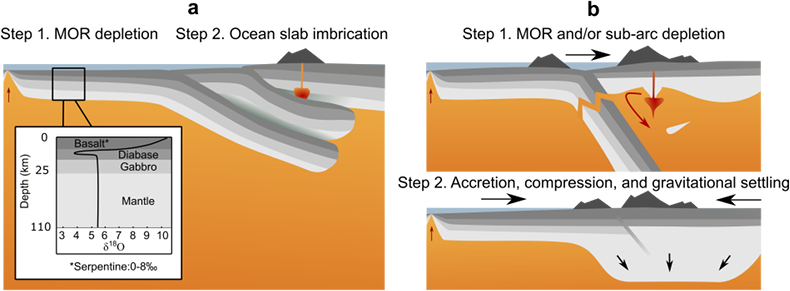
Figure 1 Popular models of cratonic mantle formation. (a) Imbrication of MOR sequences to form a thick lithosphere. An estimated oxygen isotope profile through Neoarchean oceanic lithosphere is inset. (b) Depleted cratonic mantle protoliths produced at MOR and in sub-arc environments are compressed via pure shear into a thick lithospheric root.
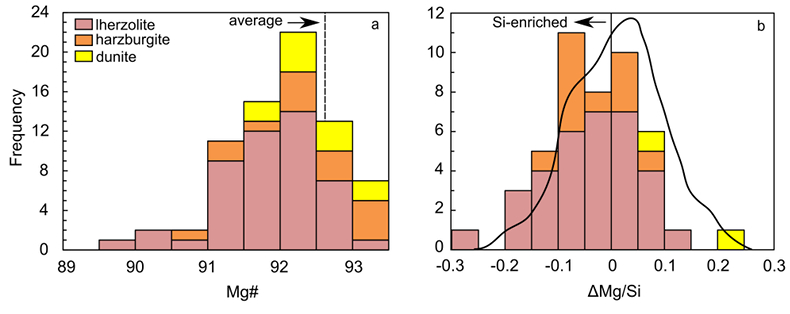
Figure 2 (a) Mg# histogram of olivines in this study. Mg#s are both more and less depleted than the worldwide average for olivine in cratonic peridotite, denoted by the dotted line (Pearson and Wittig, 2008
Pearson, D.G., Wittig, N. (2008) Formation of Archaean continental lithosphere and its diamonds: the root of the problem. Journal of the Geological Society 165, 895–914.
). (b) ΔMg/Si histogram of samples compared to a vertically unscaled probability density function for worldwide cratonic mantle xenoliths from Canil and Lee (2009)Canil, D., Lee, C.-T.A. (2009) Were deep cratonic mantle roots hydrated in Archean oceans? Geology 37, 667–670.
. Negative ΔMg/Si designates Si-enriched lithologies.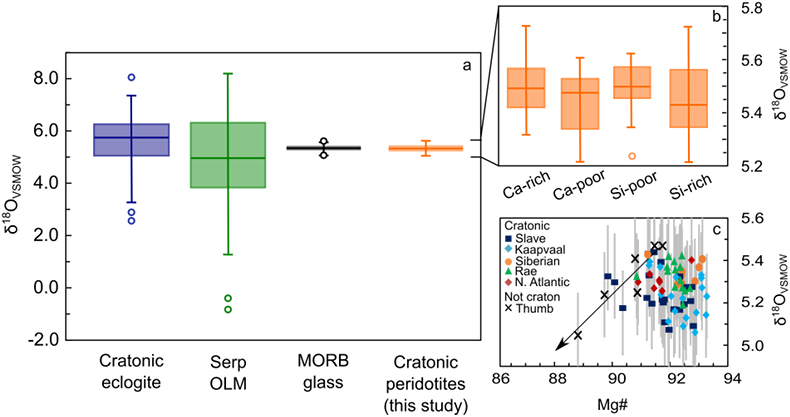
Figure 3 (a) Box-whisker plot of the oxygen isotopic composition of cratonic peridotites, calculated from olivine δ18O, compared to eclogitic xenoliths, serpentinised oceanic lithospheric mantle (OLM), and MORB glass (Supplementary Information). (b) A box-whisker plot of peridotite δ18O, divided into statistically insignificant chemical discriminators – Ca-rich (lherzolitic), Ca-poor (harzburgitic/dunitic) and Si-enriched (-ΔMg/Si) and depleted lithologies (+ΔMg/Si), demonstrates that there is no variation in the distribution of oxygen isotopes with bulk rock chemistry. (c) Scatter plot of olivine δ18O and Mg#. The lack of correlation in the cratonic mantle suite contrasts to the trendline of The Thumb xenoliths (r2 = 0.86).
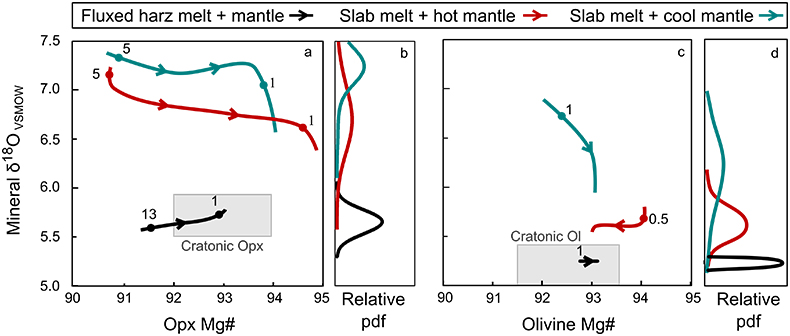
Figure 4 pMELTS modelling of slab melts (δ18O of +8 ‰) reacting with 900 ℃ (blue) and 1500 °C (red) harzburgite, as well as a water-fluxed harzburgitic (harz) melt (δ18O of +5.6 ‰) reacting with 1300 ℃ harzburgite (black). The major element and isotopic evolution of crystallising Opx (a) and olivine (c) is indicated by smoothed curves. Numbers indicate the slab melt/assimilated peridotite ratio. Typical cratonic mantle Opx and olivine (Ol) is outlined in gray fields. Relative Kernel estimations of the probability density function (pdf) for Opx (b) and olivine (d) δ18O are included.






